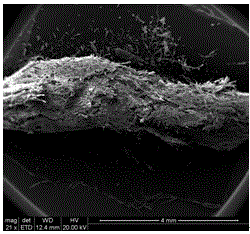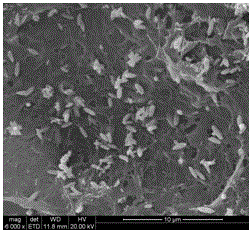A kind of nano-micro ZnO/composite cellulose strip material and preparation method thereof
A technology of composite cellulose, cellulose fiber, applied in chemical instruments and methods, nanotechnology for materials and surface science, organic compound/hydride/coordination complex catalyst, etc., can solve the high temperature of nano-ZnO , environmental pollution, unfavorable spinning into fiber or film forming process, etc., to achieve the effect of reducing the temperature of hydrothermal synthesis, cleaning and environmental protection of the preparation process, and promoting the formation of
- Summary
- Abstract
- Description
- Claims
- Application Information
AI Technical Summary
Problems solved by technology
Method used
Image
Examples
Embodiment 1
[0036] Add 1 g of wood pulp cellulose fibers to 65% (wt%) ZnCl 2 In the aqueous solution, pretreat for 4 hours in a constant temperature bath at 60°C. Use a syringe to moisten and partially dissolve the cellulose ZnCl 2 The aqueous solution was slowly injected into a 30% NaOH aqueous solution, and the precipitation time was 0.5h. When the pH value of the system was adjusted to 9, it was left to stand for 24 hours to obtain a strip-shaped ZnO precursor / cellulose. The strip-shaped ZnO precursor / cellulose was put into a hydrothermal synthesis kettle, and the hydrothermal reaction was carried out under the conditions of pH 9 and temperature 120°C, and the reaction time was 6h. Wash the strips of ZnO / cellulose to be free of Cl - Finally, put it in an ultra-low temperature refrigerator. After freezing, place the sample in a freeze dryer. After drying, a new strip-shaped nano-ZnO / cellulose fiber material is obtained.
[0037] At the same time, ZnO particles were prepared by the sa...
Embodiment 2
[0041] Add 1 g of cotton pulp cellulose fiber to 65% (wt%) ZnCl 2 In the aqueous solution, it was pretreated in a constant temperature bath at 40°C for 12h. Use a syringe to moisten and partially dissolve the cellulose ZnCl 2 The aqueous solution was slowly injected into a 20% NaOH aqueous solution, and the precipitation time was 3 hours. When the pH value of the system was adjusted to 7, it was left to stand for 36 hours to obtain a strip-shaped ZnO precursor / cellulose. The strip ZnO precursor / cellulose was put into a hydrothermal synthesis kettle, and the hydrothermal reaction was carried out under the conditions of pH 7 and temperature 170°C, and the reaction time was 4h. Wash the strips of ZnO / cellulose to be free of Cl - Finally, put it in an ultra-low temperature refrigerator. After freezing, place the sample in a freeze dryer. After drying, a new strip-shaped nano-ZnO / cellulose fiber material is obtained.
[0042] Depend on Figure 8 It can be seen that the strip Zn...
Embodiment 3
[0045] Add 1 g of bamboo pulp cellulose fibers to 65% (wt%) ZnCl 2 In aqueous solution, pretreatment in a constant temperature bath at 70°C for 2h. Use a syringe to moisten and partially dissolve the cellulose ZnCl 2 The aqueous solution was slowly injected into a 15% NaOH aqueous solution, and the precipitation time was 5 hours. When the pH value of the system was adjusted to 10, it was left to stand for 48 hours to obtain a strip-shaped ZnO precursor / cellulose. The strip-shaped ZnO precursor / cellulose was put into a hydrothermal synthesis kettle, and the hydrothermal reaction was carried out under the conditions of pH 10 and temperature 100° C., and the reaction time was 10 h. Wash the strips of ZnO / cellulose to be free of Cl - Finally, put it in an ultra-low temperature refrigerator. After freezing, place the sample in a freeze dryer. After drying, a new strip-shaped nano-ZnO / cellulose fiber material is obtained.
[0046] Depend on Figure 11 It can be seen that the str...
PUM
| Property | Measurement | Unit |
|---|---|---|
| width | aaaaa | aaaaa |
Abstract
Description
Claims
Application Information
 Login to View More
Login to View More - R&D
- Intellectual Property
- Life Sciences
- Materials
- Tech Scout
- Unparalleled Data Quality
- Higher Quality Content
- 60% Fewer Hallucinations
Browse by: Latest US Patents, China's latest patents, Technical Efficacy Thesaurus, Application Domain, Technology Topic, Popular Technical Reports.
© 2025 PatSnap. All rights reserved.Legal|Privacy policy|Modern Slavery Act Transparency Statement|Sitemap|About US| Contact US: help@patsnap.com



